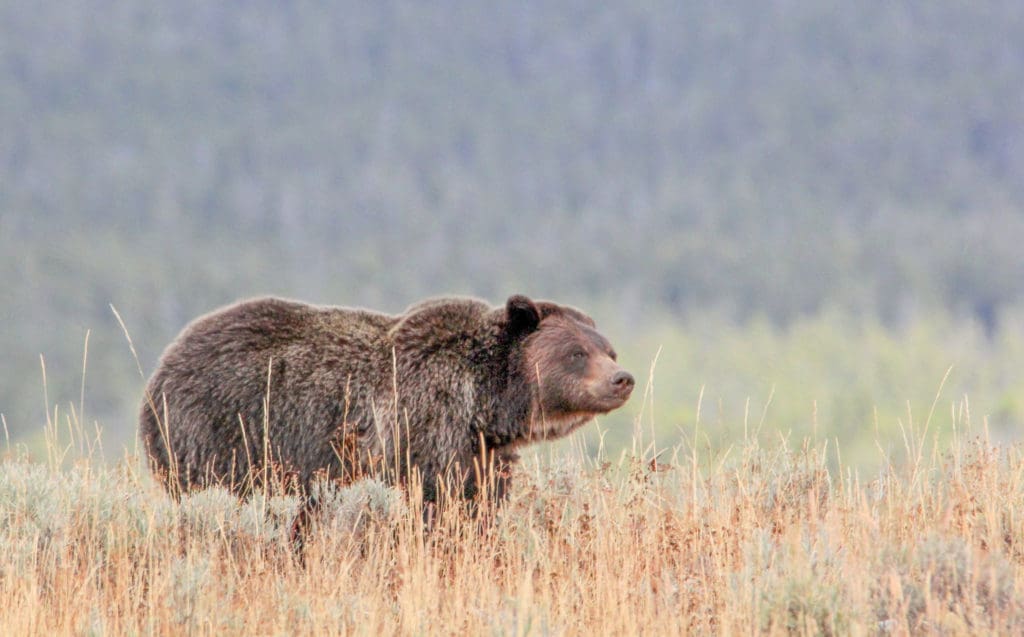The following opinion piece, written by Jessie Grossman, Y2Y’s Cabinet-Purcell Mountain Corridor Project Coordinator, originally appeared in The Missoulian on July 24, 2020.
Hiking the mountains and roadless forests of the Yaak Valley a few summers ago, I felt that deep peace being in the backcountry brings. If you’ve hiked, biked, picked huckleberries or hunted in similar places, you’re familiar.
While I knew there were bears in the area, I had never seen them on my backcountry rambles — until June 2017, when I encountered a grizzly and her cub. Thankfully I was carrying bear spray and knew what to do.
It’s common to encounter bears in parts of Montana, whether we see them on the road, see their sign in the woods, or hear stories of them getting into trouble with our neighbor’s bird-feeder. People living in communities where bears have not been seen for many years can prepare now, as grizzly bears recover from desperately low numbers and return to the areas they once lived. This is not something to fear, especially if we prepare now to help both communities and wildlife thrive.
While a reminder to Montanans that we live in a wild place, one with enough space to support grizzly bears and other large creatures, many of us take bears for granted. Grizzlies face real issues in Montana and are “threatened” under the Endangered Species Act. Four of six recovery areas identified by the U.S. Fish and Wildlife Service in the Grizzly Bear Recovery Plan are in Montana, including the Cabinet-Yaak. All areas in the state have been on a positive path to recovery, yet there is more work to do.
A governor-appointed Grizzly Bear Advisory Council has been tasked with helping find a better future for the bruins and people. It’s a group with a diverse set of backgrounds, interests and approaches from across the state, made of educators, business owners, ranchers and conservationists. I have seen firsthand they are working together on a set of recommendations to influence how Montana Fish, Wildlife and Parks works alongside tribes, federal agencies, non-profits and the public to support the continued health of bears and people. This collective action is what we need.
These 18 folks will help create recommendations for improving human safety, making sure grizzly bear populations are healthy, and preventing grizzly bear conflicts.
An executive order from the governor states why Montanans are committed to maintaining the long-term success of grizzly bears and lays out the ways to balance their needs with those of people. The final report to the Governor is due in August, but you can get involved now by attending virtual meetings and sending your comments to Montana Wildlife Fish and Parks on state grizzly bears.
These days I live in Troy and work to highlight what these bears need through my role at Yellowstone to Yukon Conservation Initiative. To help them recover, we can’t just make sure they endure into the future, but thrive, as they share spaces with people. The biggest opportunity is to do what’s needed to keep ourselves and bears safe. Once habituated, it rarely ends well for bears. Luckily, in my encounter years ago, the mother and cub took off when I used bear spray.
Montana Fish, Wildlife, and Parks has dedicated and passionate bear management specialists who help people live life exactly the way they want in grizzly country. One recommendation from the Advisory Council I’d like to see is more funding, resources and tools to help these specialists succeed as important resources to our communities.
Grizzly bears, incredible icons of the West, deserve to be more than history. They are one of the many things that make living in Montana special. It’s on us to ensure they have a future.


